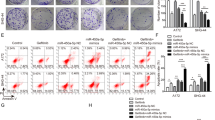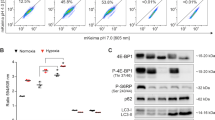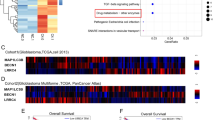Abstract
The mammalian target of rapamycin (mTOR) plays a central role in regulating the proliferation of malignant glioma cells, and mTOR-specific inhibitors such as rapamycin analogs are considered as promising therapy for malignant gliomas. However, the efficacy of mTOR inhibitors alone in the treatment of patients with malignant gliomas is only modest, potentially because these agents rather than acting as mTOR kinase inhibitors instead interfere with the function of only mTOR/raptor (regulatory-associated protein of mTOR) complex and thus do not perturb all mTOR functions. The purpose of this study was to determine whether global inhibition of the mTOR molecule enhances the antitumor effect of rapamycin on malignant glioma cells. We showed that rapamycin induced autophagy and that inhibition of autophagy by small interfering RNA (siRNA) directed against autophagy-related gene Beclin 1 attenuated the cytotoxicity of rapamycin in rapamycin-sensitive tumor cells, indicating that the autophagy was a primary mediator of rapamycin's antitumor effect rather than a protective response. Exogenous expression of an mTOR mutant interfering with its kinase activity markedly enhanced the incidence of rapamycin-induced autophagy. Moreover, silencing of mTOR with siRNA augmented the inhibitory effect of rapamycin on tumor cell viability by stimulating autophagy. Importantly, not only rapamycin-sensitive malignant glioma cells with PTEN mutations but also rapamycin-resistant malignant glioma cells with wild-type PTEN were sensitized to rapamycin by mTOR siRNA. These results indicate that rapamycin-induced autophagy is one of the agent's antitumor effects and that silencing or inhibiting mTOR kinase activity could enhance the effectiveness of rapamycin.
This is a preview of subscription content, access via your institution
Access options
Subscribe to this journal
Receive 50 print issues and online access
$259.00 per year
only $5.18 per issue
Buy this article
- Purchase on Springer Link
- Instant access to full article PDF
Prices may be subject to local taxes which are calculated during checkout






Similar content being viewed by others
References
Adachi J, Ohbayashi K, Suzuki T, Sasaki T . (1999). Cell cycle arrest and astrocytic differentiation resulting from PTEN expression in glioma cells. J Neurosurg 91: 822–830.
Avellino R, Romano S, Parasole R, Bisogni R, Lamberti A, Poggi V et al. (2005). Rapamycin stimulates apoptosis of childhood acute lymphoblastic leukemia cells. Blood 106: 1400–1406.
Bjornsti MA, Houghton PJ . (2004). The TOR pathway: a target for cancer therapy. Nat Rev Cancer 4: 335–348.
Castedo M, Ferri KF, Kroemer G . (2002). Mammalian target of rapamycin (mTOR): pro- and anti-apoptotic. Cell Death Differ 9: 99–100.
Cuervo AM . (2004). Autophagy: in sickness and in health. Trends Cell Biol 14: 70–77.
Daido S, Yamamoto A, Fujiwara K, Sawaya R, Kondo S, Kondo Y . (2005). Inhibition of the DNA-dependent protein kinase catalytic subunit radiosensitizes malignant glioma cells by inducing autophagy. Cancer Res 65: 4368–4375.
Edinger AL, Linardic CM, Chiang GG, Thompson CB, Abraham RT . (2003). Differential effects of rapamycin on mammalian target of rapamycin signaling functions in mammalian cells. Cancer Res 63: 8451–8460.
Furuta S, Hidaka E, Ogata A, Yokota S, Kamata T . (2004). Ras is involved in the negative control of autophagy through the class I PI3-kinase. Oncogene 23: 3898–3904.
Galanis E, Buckner JC, Maurer MJ, Kreisberg JI, Ballman K, Boni J et al. (2005). Phase II trial of temsirolimus (CCI-779) in recurrent glioblastoma multiforme: a North Central Cancer Treatment Group Study. J Clin Oncol 23: 5294–5304.
Gozuacik D, Kimchi A . (2004). Autophagy as a cell death and tumor suppressor mechanism. Oncogene 23: 2891–2906.
Guertin DA, Sabatini DM . (2005). An expanding role for mTOR in cancer. Trends Mol Med 11: 353–361.
Gutierrez MG, Master SS, Singh SB, Taylor GA, Colombo MI, Deretic V . (2004). Autophagy is a defense mechanism inhibiting BCG and Mycobacterium tuberculosis survival in infected macrophages. Cell 119: 753–766.
Hosoi H, Dilling MB, Shikata T, Liu LN, Shu L, Ashmun RA et al. (1999). Rapamycin causes poorly reversible inhibition of mTOR and induces p53-independent apoptosis in human rhabdomyosarcoma cells. Cancer Res 59: 886–894.
Huang S, Houghton PJ . (2003). Targeting mTOR signaling for cancer therapy. Curr Opin Pharmacol 3: 371–377.
Ito H, Kanzawa T, Miyoshi T, Hirohata S, Kyo S, Iwamaru A et al. (2005). Therapeutic efficacy of PUMA for malignant glioma cells regardless of p53 status. Hum Gene Ther 16: 685–698.
Kabeya Y, Mizushima N, Ueno T, Yamamoto A, Kirisako T, Noda T et al. (2000). LC3, a mammalian homologue of yeast Apg8p, is localized in autophagosome membranes after processing. EMBO J 19: 5720–5728.
Kanazawa T, Taneike I, Akaishi R, Yoshizawa F, Furuya N, Fujimura S et al. (2004). Amino acids and insulin control autophagic proteolysis through different signaling pathways in relation to mTOR in isolated rat hepatocytes. J Biol Chem 279: 8452–8459.
Kanzawa T, Zhang L, Xiao L, Germano IM, Kondo Y, Kondo S . (2005). Arsenic trioxide induces autophagic cell death in malignant glioma cells by up-regulation of mitochondrial cell death protein, BNIP3. Oncogene 24: 980–991.
Kim DH, Sarbassov DD, Ali SM, King JE, Latek RR, Erdjument-Bromage H et al. (2002). mTOR interacts with raptor to form a nutrient-sensitive complex that signals to the cell growth machinery. Cell 110: 163–175.
Klionsky DJ, Emr SD . (2000). Autophagy as a regulated pathway of cellular degradation. Science 290: 1717–1721.
Kondo Y, Kanzawa T, Sawaya R, Kondo S . (2005). Role of autophagy in cancer development and response to therapy. Nat Rev Cancer 5: 726–734.
Levine B, Klionsky DJ . (2004). Development by self-digestion: molecular mechanisms and biological functions of autophagy. Dev Cell 6: 463–477.
Liang XH, Jackson S, Seaman M, Brown K, Kempkes B, Hibshoosh H et al. (1999). Induction of autophagy and inhibition of tumorigenesis by beclin 1. Nature 402: 672–676.
Loewith R, Jacinto E, Wullschleger S, Lorberg A, Crespo JL, Bonenfant D et al. (2002). Two TOR complexes, only one of which is rapamycin sensitive, have distinct roles in cell growth control. Mol Cell 10: 457–468.
Majumder PK, Febbo PG, Bikoff R, Berger R, Xue Q, McMahon LM et al. (2004). mTOR inhibition reverses Akt-dependent prostate intraepithelial neoplasia through regulation of apoptotic and HIF-1-dependent pathways. Nat Med 10: 594–601.
Mitchell P, Ellison DW, Mendelow AD . (2005). Surgery for malignant gliomas: mechanistic reasoning and slippery statistics. Lancet Neurol 4: 413–422.
Mizushima N, Yamamoto A, Hatano M, Kobayashi Y, Kabeya Y, Suzuki K et al. (2001). Dissection of autophagosome formation using Apg5-deficient mouse embryonic stem cells. J Cell Biol 152: 657–668.
Morimoto AM, Berson AE, Fujii GH, Teng DH, Tavtigian SV, Bookstein R et al. (1999). Phenotypic analysis of human glioma cells expressing the MMAC1 tumor suppressor phosphatase. Oncogene 18: 1261–1266.
Nepomuceno RR, Balatoni CE, Natkunam Y, Snow AL, Krams SM, Martinez OM . (2003). Rapamycin inhibits the interleukin 10 signal transduction pathway and the growth of Epstein Barr virus B-cell lymphomas. Cancer Res 63: 4472–4480.
Noda T, Ohsumi Y . (1998). Tor, a phosphatidylinositol kinase homologue, controls autophagy in yeast. J Biol Chem 273: 3963–3966.
Ogier-Denis E, Codogno P . (2003). Autophagy: a barrier or an adaptive response to cancer. Biochim Biophys Acta 1603: 113–128.
Oldham S, Hafen E . (2003). Insulin/IGF and target of rapamycin signaling: a TOR de force in growth control. Trends Cell Biol 13: 79–85.
O'Reilly KE, Rojo F, She QB, Solit D, Mills GB, Smith D et al. (2006). mTOR inhibition induces upstream receptor tyrosine kinase signaling and activates Akt. Cancer Res 66: 1500–1508.
Peralba JM, DeGraffenried L, Friedrichs W, Fulcher L, Grunwald V, Weiss G et al. (2003). Pharmacodynamic evaluation of CCI-779, an inhibitor of mTOR, in cancer patients. Clin Cancer Res 9: 2887–2892.
Qu X, Yu J, Bhagat G, Furuya N, Hibshoosh H, Troxel A et al. (2003). Promotion of tumorigenesis by heterozygous disruption of the beclin 1 autophagy gene. J Clin Invest 112: 1809–1820.
Ravikumar B, Vacher C, Berger Z, Davies JE, Luo S, Oroz LG et al. (2004). Inhibition of mTOR induces autophagy and reduces toxicity of polyglutamine expansions in fly and mouse models of Huntington disease. Nat Genet 36: 585–595.
Sawyers CL . (2003). Will mTOR inhibitors make it as cancer drugs? Cancer Cell 4: 343–348.
Sekulic A, Hudson CC, Homme JL, Yin P, Otterness DM, Karnitz LM et al. (2000). A direct linkage between the phosphoinositide 3-kinase-AKT signaling pathway and the mammalian target of rapamycin in mitogen-stimulated and transformed cells. Cancer Res 60: 3504–3513.
Shi Y, Yan H, Frost P, Gera J, Lichtenstein A . (2005). Mammalian target of rapamycin inhibitors activate the AKT kinase in multiple myeloma cells by up-regulating the insulin-like growth factor receptor/insulin receptor substrate-1/phosphatidylinositol 3-kinase cascade. Mol Cancer Ther 4: 1533–1540.
Shintani T, Klionsky DJ . (2004). Autophagy in health and disease: a double-edged sword. Science 306: 990–995.
Sun SY, Rosenberg LM, Wang X, Zhou Z, Yue P, Fu H et al. (2005). Activation of Akt and eIF4E survival pathways by rapamycin-mediated mammalian target of rapamycin inhibition. Cancer Res 65: 7052–7058.
Surawicz TS, Davis F, Freels S, Laws Jr ER, Menck HR . (1998). Brain tumor survival: results from the National Cancer Data Base. J Neurooncol 40: 151–160.
Takeuchi H, Kondo Y, Fujiwara K, Kanzawa T, Aoki H, Mills GB et al. (2005). Synergistic augmentation of rapamycin-induced autophagy in malignant glioma cells by phosphatidylinositol 3-kinase/protein kinase B inhibitors. Cancer Res 65: 3336–3346.
Vivanco I, Sawyers CL . (2002). The phosphatidylinositol 3-kinase AKT pathway in human cancer. Nat Rev Cancer 2: 489–501.
Vogt PK . (2001). PI 3-kinase, mTOR, protein synthesis and cancer. Trends Mol Med 7: 482–484.
Yu L, Alva A, Su H, Dutt P, Freundt E, Welsh S et al. (2004). Regulation of an ATG7-beclin 1 program of autophagic cell death by caspase-8. Science 304: 1500–1502.
Yue Z, Jin S, Yang C, Levine AJ, Heintz N . (2003). Beclin 1, an autophagy gene essential for early embryonic development, is a haploinsufficient tumor suppressor. Proc Natl Acad Sci USA 100: 15077–15082.
Zhang H, Cicchetti G, Onda H, Koon HB, Asrican K, Bajraszewski N et al. (2003). Loss of Tsc1/Tsc2 activates mTOR and disrupts PI3K-Akt signaling through downregulation of PDGFR. J Clin Invest 112: 1223–1233.
Acknowledgements
We thank Dr Noboru Mizushima for the GFP-LC3 vector, Dr Robert T Abraham for the mTOR mutant SIDA vector and Emporia F Hollingsworth for technical assistance. We also thank Elizabeth L Hess for editing the manuscript. This work was supported from National Cancer Institute Grants CA088936 and CA108558, a start-up fund from The University of Texas MD Anderson Cancer Center (SK), a generous donation from the Anthony D. Bullock III Foundation (YK, SK) and Cancer Center Support Grant (CCSG)/Shared Resources of National Cancer Institute.
Author information
Authors and Affiliations
Corresponding author
Rights and permissions
About this article
Cite this article
Iwamaru, A., Kondo, Y., Iwado, E. et al. Silencing mammalian target of rapamycin signaling by small interfering RNA enhances rapamycin-induced autophagy in malignant glioma cells. Oncogene 26, 1840–1851 (2007). https://doi.org/10.1038/sj.onc.1209992
Received:
Revised:
Accepted:
Published:
Issue Date:
DOI: https://doi.org/10.1038/sj.onc.1209992
Keywords
This article is cited by
-
Tanshinone IIA targeting cell signaling pathways: a plausible paradigm for cancer therapy
Pharmacological Reports (2023)
-
TAK1 mediates convergence of cellular signals for death and survival
Apoptosis (2019)
-
A large-scale RNA interference screen identifies genes that regulate autophagy at different stages
Scientific Reports (2018)
-
Autophagy regulation by nutrient signaling
Cell Research (2014)
-
Emerging roles of radioresistance in prostate cancer metastasis and radiation therapy
Cancer and Metastasis Reviews (2014)



